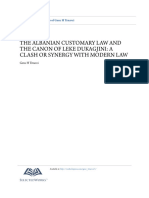The Emperor
The Emperor
Uploaded by
Richa MishraCopyright:
Available Formats
The Emperor
The Emperor
Uploaded by
Richa MishraOriginal Title
Copyright
Available Formats
Share this document
Did you find this document useful?
Is this content inappropriate?
Copyright:
Available Formats
The Emperor
The Emperor
Uploaded by
Richa MishraCopyright:
Available Formats
The emperor Akbar (15561605) built largely, and the style developed vigorously during his reign.
As in the Gujarat and other styles, there is a combination of Muslim and Hindu features in his works. Akbar constructed the royal city of Fatehpur Sikri, located 26 miles (42 km) west of Agra, in the late 16th century. The numerous structures at Fatehpur Sikri best illustrate the style of his works - the southern gateway of the mosque, which is known as Buland Darwaza, is the largest of its kind in India. The Mughals also built tombs, which include the tomb of Akbar's father Humayun, and the Tomb of Akbar the Great at Sikandra, near Agra.
Tomb of Itimad-ud-Daula, Agra
Under Jahangir (16051627) the Hindu features vanished from the style; his great mosque at Lahore is in the Persian style, covered with enamelled tiles. Itimad-ud-daulahHe also built a monument to his pet deer, Hiram Miner in Sheikhupura, Pakistan and due to his great love for his wife, after his death she went on to build his mausoleum in Lahore.
Architectural Panel, Mughal dynasty, late 17th century, India. This panel either hung in the doorway of a palace or lined a noblemans tent.
[edit]Shah
Jahan
Jama Masjid, Delhi.
The force and originality of the style gave way under Shah Jahan (16271658) to a delicate elegance and refinement of detail, illustrated in the palaces erected in his reign at Agra and Delhi. Some examples include the Taj Mahal at Agra and the tomb of Mumtaz Mahal, the wife of Jahan. The Moti Masjid (Pearl Mosque) in the Agra Fort and TheJama Masjid at Delhi are imposing buildings, and their position and architecture have been carefully considered so as to produce a pleasing effect and feeling of spacious elegance and wellbalanced proportion of parts. Jahan also built the Tomb of Jahangir and sections of theLahore Fort that include the Moti Masjid, Sheesh Mahal, and Naulakha pavilion which are all enclosed in the fort. He also built a mosque named after himself in Thatta called Shahjahan Mosque. Another mosque was built during his tenure in Lahore called Wazir Khan Mosque, by Shaikh Ilm-ud-din Ansari who was the court physician to the emperor. [Edit]Taj
Mahal
Main article: Taj Mahal The Taj Mahal, the "teardrop on the cheek of eternity" (Rabindranath Tagore), was completed in 1648 by the emperor Shah Jahan in memory of his wife Mumtaz Mahal. Its longest plane of symmetry runs through the entire complex except for the sarcophagus of Shah Jahan, which is placed off centre in the crypt room below the main floor. This symmetry extended to the building of an entire mirror mosque in red sandstone, to complement the Mecca-facing mosque place to the west of the main structure. The Taj Mahal (16301648) in Agra, India and the Shalimar Garden (16411642) in Lahore, Pakistan, are two sites which are on the world heritage list of UNESCO. The Taj is considered[by whom?] to be one of the most beautiful monuments of the world and was included in theNew Seven Wonders of the World list. [edit]Aurangzeb
and later Mughal architecture
A view of a pavilion in Shalimar Garden, Lahore, Pakistan
Lalbagh Fort, constructed in the mid-17th century in Dhaka during the reign of Aurangzeb
In Aurangzeb's reign (16581707) squared stone and marble was replaced by brick or rubble with stucco ornament. Srirangapatnaand Lucknow have examples of later Indo-Muslim architecture. He made additions to the Lahore Fort and also built one of the thirteen gates which was later named after him (Alamgir). Aurangzeb also built the Badshahi Mosque which was constructed in 1674 under the supervision of Fida'i Koka. This mosque is adjacent to the Lahore Fort and is the last in the series of congregational mosques in red sandstone and is closely modeled on the one Shah Jahan built at Shahjahanabad. The red sandstone of the walls contrasts with the white marble of the domes and the subtle intarsia decoration. Additional monuments from this period are associated with women from Aurangzeb's imperial family. The construction of the elegantZinat al-Masjid in Daryaganij was overseen by Aurangzeb's second daughter Zinat al-Nisa. Aurangzeb's sister Roshan-Ara who died in 1671. The tomb of Roshanara Begum and the garden surrounding it were neglected for a long time and are now in an advanced state of decay. Bibi Ka Maqbara was a mausoleum built by Prince Azam Shah, son of Emperor Aurangzeb, in the late 17th century as a loving tribute to his mother, Dilras Bano Begam in Aurangabad, Maharashtra. The Alamgiri Gate, built in 1673 A.D., is the main entrance to the Lahore Fort in present day Lahore. It was constructed to face west towards the Badshahi Mosquein the days of the Mughal Emperor Aurangzeb. Another construction of Mughal era is the Lalbagh Fort (also known as "Fort Aurangabad"), a Mughal palace fortress at theBuriganga River in the southwestern part of Dhaka, Bangladesh, whose construction started in 1678 during the reign ofAurangzeb.[4] '== Mughal gardens == Main article: Mughal Gardens
Palace of Nawab Asaf-Ud-Dowlah.
Mughal gardens are a group of gardens built by the Mughals in the Islamic style of architecture. This style was influenced by Persian gardens and Timurid gardens. Significant use of rectilinear layouts are made within the walled enclosures. Some of the typical features include pools, fountains and canals inside the gardens. The famous gardens are the Char Bagh gardens at Taj Mahal, Shalimar Gardens of Lahore, Delhi and Kashmir as well as Pinjore Garden in Haryana.
You might also like
- Lab 5 Work and Energy On Air Track PDFDocument27 pagesLab 5 Work and Energy On Air Track PDFMuhammad Usman Malik100% (1)
- History - Mughal Art and ArchitectureDocument12 pagesHistory - Mughal Art and ArchitectureblazegloryNo ratings yet
- Taj Mahal 02Document19 pagesTaj Mahal 02Manish KaliaNo ratings yet
- Answer KeyDocument10 pagesAnswer Keyonedirection100% (1)
- Human Anatomy & Physiology Marieb Chapter 1Document6 pagesHuman Anatomy & Physiology Marieb Chapter 1JayjayNo ratings yet
- 3810 Master SyllabusDocument2 pages3810 Master Syllabusapi-282606106No ratings yet
- Mughal Architecture: Main Article: Akbari ArchitectureDocument12 pagesMughal Architecture: Main Article: Akbari ArchitectureKarthik Subramanya100% (1)
- History ProjectDocument33 pagesHistory Projectतेजस्विनी रंजन100% (2)
- Mughal Monuments: Humayun's Tomb (Maqbara e Humayun) Is The Tomb of The Mughal Emperor Humayun in Delhi, India. TheDocument2 pagesMughal Monuments: Humayun's Tomb (Maqbara e Humayun) Is The Tomb of The Mughal Emperor Humayun in Delhi, India. Thehodibaaba1No ratings yet
- Mughal Architecture: Presentation TopicDocument37 pagesMughal Architecture: Presentation TopicFA20-CHE-107 (ABDULMOEEZ ) UnknownNo ratings yet
- Mughal Architecture Is An: Akbari SaraiDocument5 pagesMughal Architecture Is An: Akbari SaraiBISWARUP PALNo ratings yet
- 1 Mughal ArchitectureDocument152 pages1 Mughal ArchitectureShibani SenguptaNo ratings yet
- Mughal Architecture: Presentation TopicDocument25 pagesMughal Architecture: Presentation TopicFA20-CHE-107 (ABDULMOEEZ ) UnknownNo ratings yet
- Mughal ArchitectureDocument1 pageMughal ArchitectureAkash Patel0% (1)
- Mughal ArchitectureDocument9 pagesMughal ArchitectureRobert HowardNo ratings yet
- Article For USC MAG About LahoreDocument2 pagesArticle For USC MAG About LahoreFiazjamal79No ratings yet
- Places in AgraDocument6 pagesPlaces in Agrakarndev singhNo ratings yet
- 1) Humayun's Tomb: "The Arrival of The Mughals Was A Turning Point in Indian History, More So in Its Architecture."Document4 pages1) Humayun's Tomb: "The Arrival of The Mughals Was A Turning Point in Indian History, More So in Its Architecture."Jigyasa AtreyaNo ratings yet
- Report On Agra ND JaipurDocument12 pagesReport On Agra ND JaipurHarish NegiNo ratings yet
- MughalDocument18 pagesMughalDevi Reddy Sainath Reddy100% (1)
- Mughal ArchitectureDocument1 pageMughal ArchitectureOmerNo ratings yet
- Shah Jahan PresentationDocument30 pagesShah Jahan PresentationjyothibellaryvNo ratings yet
- Mughal PeriodDocument10 pagesMughal PeriodRiya MehtaNo ratings yet
- Mughal Buildings and Forts by Mughal Kings FinishingDocument18 pagesMughal Buildings and Forts by Mughal Kings FinishingJUNNURAIN CHOWDHURYNo ratings yet
- Lahore FortDocument5 pagesLahore FortHashmat AlamNo ratings yet
- Shah JahanDocument2 pagesShah JahanamitkumarberaNo ratings yet
- Mughal ArchitectureDocument9 pagesMughal ArchitectureLettisha LijuNo ratings yet
- Indian ArchiDocument13 pagesIndian Archiarisjfelina033No ratings yet
- PML1Document2 pagesPML1jafasoh293No ratings yet
- Islamic Architecture: MosqueDocument49 pagesIslamic Architecture: MosqueJaypee TanNo ratings yet
- Chapter - 5Document7 pagesChapter - 5bushrastudies4No ratings yet
- AgraDocument2 pagesAgraAbhishek KumarNo ratings yet
- Taj MahalDocument12 pagesTaj MahalBynun UteroNo ratings yet
- Taj MahalDocument9 pagesTaj Mahalsnigdhabanerjee1985No ratings yet
- Antora (Architecture)Document6 pagesAntora (Architecture)Alo ChayaNo ratings yet
- Mughal ArchitectureDocument11 pagesMughal ArchitecturePrem KumarNo ratings yet
- TimelineDocument6 pagesTimelineRitika RituNo ratings yet
- Name: Kazim Abbas Section: B ROLLNO: 17-050 Subject: Hac Topic: Elements of Mughal Architecture With 2 ExamplesDocument8 pagesName: Kazim Abbas Section: B ROLLNO: 17-050 Subject: Hac Topic: Elements of Mughal Architecture With 2 ExamplesKazim AbbasNo ratings yet
- Rule of Shah Jahan and His ArchitectureDocument14 pagesRule of Shah Jahan and His ArchitectureRisha KadeejaNo ratings yet
- Contribution of The Mughals in The Field of Art and ArcitectureDocument12 pagesContribution of The Mughals in The Field of Art and ArcitectureAshwinie RaiNo ratings yet
- Plate 1. Tomb of Ali Mardan Khan at LahoreDocument20 pagesPlate 1. Tomb of Ali Mardan Khan at LahoreNida AbbasiNo ratings yet
- Taj MahalDocument2 pagesTaj MahalkarisajachNo ratings yet
- AIP SocialDocument8 pagesAIP Socialannroy2418No ratings yet
- Buland DarwazaDocument3 pagesBuland DarwazaTimothy BrownNo ratings yet
- DipuDocument3 pagesDipuAnsu MishraNo ratings yet
- Mughal ArchitectureDocument59 pagesMughal ArchitectureAndromeda Blaire100% (1)
- Mughal Architecture and PaintingsDocument29 pagesMughal Architecture and Paintingsbapijal386No ratings yet
- Taj Mahal: Origin and InspirationDocument2 pagesTaj Mahal: Origin and InspirationVipin KumarNo ratings yet
- Shah Jehan AssignmentDocument4 pagesShah Jehan AssignmentSaqlain AbbasNo ratings yet
- Muslim Archetecture FinalDocument26 pagesMuslim Archetecture FinalMag NumNo ratings yet
- Mughal architectureDocument7 pagesMughal architectureabhibhattacharjee726No ratings yet
- The Taj MahalDocument1 pageThe Taj Mahalalvinamariya2009No ratings yet
- History of LahoreDocument39 pagesHistory of LahoreFizatahirNo ratings yet
- AkbarDocument36 pagesAkbarFahad KhanNo ratings yet
- Architecture of The Mughal PeriodDocument6 pagesArchitecture of The Mughal PeriodArslan AsifNo ratings yet
- Taj Mahal Is Regarded As One of The Eight Wonders of The WorldDocument5 pagesTaj Mahal Is Regarded As One of The Eight Wonders of The WorldelainemagcalasNo ratings yet
- JETIR1912200Document12 pagesJETIR1912200nexusforbusiness7No ratings yet
- Mughal Art English 28Document9 pagesMughal Art English 28Nikita KohliNo ratings yet
- Taj MahalDocument2 pagesTaj MahalMoni LisaNo ratings yet
- History Project 7DDocument12 pagesHistory Project 7DSanthosh M K ShetNo ratings yet
- Mughal Contribution To Art, Architecture and CultureDocument20 pagesMughal Contribution To Art, Architecture and Culturetahmida ahmed laskarNo ratings yet
- Indian MonumentsDocument15 pagesIndian MonumentsManan JoshiNo ratings yet
- FreeReadingComprehensionPassages PDFDocument12 pagesFreeReadingComprehensionPassages PDFnguyenmaithanh100% (3)
- Post AssessmentDocument30 pagesPost Assessmentmahifin599No ratings yet
- 25 Yrs of Educating Children With Disabilities Thru IDEADocument6 pages25 Yrs of Educating Children With Disabilities Thru IDEASami HartsfieldNo ratings yet
- Scope of Endodontics: DefinitionDocument5 pagesScope of Endodontics: DefinitionRana SayedNo ratings yet
- L&T Rotary Switch Meters PDFDocument44 pagesL&T Rotary Switch Meters PDFSukhirthan SenthilkumarNo ratings yet
- Respiratory Medicine 151 200Document31 pagesRespiratory Medicine 151 200Ahmed Kh. Abu Warda100% (2)
- Divided India - Rajendra PrasadDocument465 pagesDivided India - Rajendra PrasadVeeramani Mani80% (5)
- PerceptionDocument5 pagesPerceptionrupali.kulkarniNo ratings yet
- Discipline Report: Hephzibah Middle School Richmond CountyDocument4 pagesDiscipline Report: Hephzibah Middle School Richmond CountyJeremy TurnageNo ratings yet
- DIVORCE Position PaperDocument5 pagesDIVORCE Position PaperYza Clarizh M. Cambosa-ReyesNo ratings yet
- Strategies For Group MeetingDocument10 pagesStrategies For Group MeetingHaceib (HaceiB)No ratings yet
- Dilcher 1974Document158 pagesDilcher 1974Antonio NetoNo ratings yet
- 100 Proven Hooks to Make Your Twitter Threads Go ViralDocument4 pages100 Proven Hooks to Make Your Twitter Threads Go ViralAbba BelloNo ratings yet
- Homework Chapter 9Document15 pagesHomework Chapter 9Trung Kiên Nguyễn50% (2)
- Humanitarian Law 2nd AssignmentDocument8 pagesHumanitarian Law 2nd AssignmentevaristophiritanazyoNo ratings yet
- 10-Sense OrgansDocument32 pages10-Sense Organsmesutor100% (2)
- ATLANTIC, GULF & C. CO. v. GOVT. OF PHILIPPINE ISLANDS, 219 U.S. 17 (1910)Document4 pagesATLANTIC, GULF & C. CO. v. GOVT. OF PHILIPPINE ISLANDS, 219 U.S. 17 (1910)Scribd Government DocsNo ratings yet
- Report Biosci (Kingdoms of Classification)Document10 pagesReport Biosci (Kingdoms of Classification)Raven StödômīngöNo ratings yet
- The Albanian Customary Law and The Canon of Leke Dukagjini - A Clash or Synergy With Modern LawDocument25 pagesThe Albanian Customary Law and The Canon of Leke Dukagjini - A Clash or Synergy With Modern LawUarda MuratiNo ratings yet
- Practical Research Week 1 q4 LT 2, LT 3Document2 pagesPractical Research Week 1 q4 LT 2, LT 3raniel gutierrezNo ratings yet
- Book 1 Loss ofDocument50 pagesBook 1 Loss ofNJT STUDENTSNo ratings yet
- Vikas, 54, Drafting, Pleading and ConveyanceDocument59 pagesVikas, 54, Drafting, Pleading and ConveyanceShivam Mishra100% (1)
- Advanced Troubleshooting of Citrix NetScalerDocument50 pagesAdvanced Troubleshooting of Citrix NetScalerTirza Sagredo de RaniNo ratings yet
- PanelHospitalsMay2024Document3 pagesPanelHospitalsMay2024Sami MughalNo ratings yet
- SavedrecsDocument508 pagesSavedrecsIsha AryaNo ratings yet
- Learn Yoruba - FSI Intermediate CourseDocument267 pagesLearn Yoruba - FSI Intermediate Course101_languages100% (3)

























































































